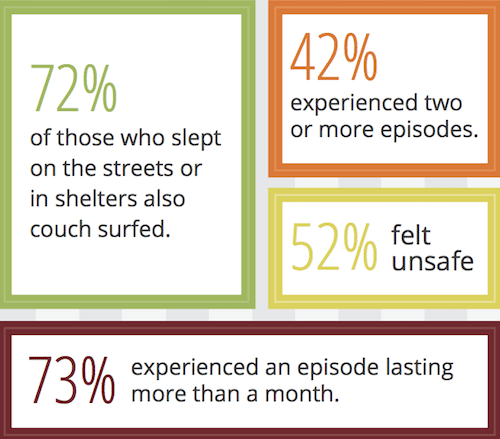Homelessness affects about one in ten youth ages 18-25 and one in 30 youth ages 13-17 in the United States. Nearly three quarters of unaccompanied youth “couch surf,” making them especially difficult to reach—and to count.

Before I arrived at Boston University’s School of Public Health, I was an outreach worker in central California. My co-worker and I walked the same three-mile route every day through the streets of one of the Sunshine State’s many wealthy, picturesque towns. We were looking for homeless or at-risk adolescents and young adults who travel up and down the Pacific Coast Highway. Our backpack held first-aid supplies, granola bars, socks, toothbrushes and water, and we encouraged anyone under age of 22 to visit our drop-in center. There, we supported clients as they wrote resumes, researched jobs, found housing, or sought out food or medical benefits.
Often, our clients just wanted to reach out to their families or friends. As soon they walked into the shelter, many would seek out an outlet to charge their phones. We would suspend our “no social media” rule if Facebook was the only way for them to make plans to go home or let someone know they were okay. If they did not have their own phone, ours was available for calls to social services, doctors’ offices, or prospective employers.
Research shows that youth experiencing homelessness still have significant access to cell phones and social media. One study found that 90% use Facebook regularly, and another found that 93% use technology at least weekly. Researcher Eric Rice found that 40% of the 169 homeless youth participants he interviewed owned a working cell phone.
Rice has headed several studies on technology, social networks, and resilience among this especially vulnerable, transient population. He and his colleagues have found that transient youth have more access to technology than most people would think. Social media and technology are a major source of social capital for youth. They use email to connect with parents and potential employers and social media to connect with peers. Ultimately, Rice has also found that connections with family, peers, and employers can improve health and social outcomes for these youth.
More and more, evidence shows that effective connections with clients struggling with homelessness—especially youth—can be made online. Tech developers and researchers have recently begun collaborating to design apps to meet clients’ health needs.
More and more, evidence shows that effective connections with clients struggling with homelessness—especially youth—can be made online. Tech developers and researchers have recently begun collaborating to design apps to meet clients’ health needs.
Electronic case management (ECM), for instance, allows case managers to stay in contact with highly mobile clients who move around too much for in-person meetings to be feasible. An organization called Hack4Impact teamed up with the University of Pennsylvania School of Social Policy and Practice, and Juvenile Law Center on an app called YouthMatters: Philly for youth and young adults who have aged out of foster care struggling to fulfill their basic needs. It provides maps, resources (e.g. where to access food, clothing, case management, mental health services, doctors), and information like hours, contact information, and quality of various services as rated by their peers.
Phone ownership can also come with downsides, such as the harassment and theft many of my clients in California experienced on a regular basis. Many of our clients reported having their phones stolen as they slept. But researcher Larissa Jennings and colleagues explain that creative strategies can help to mitigate these threats: “integrating hidden phones, financial support, and safety management may improve homeless youth’s access to and engagement with Health strategies over time.”
One of the first lessons I learned working in outreach was to “meet the client where they were at.” It’s a common maxim of the harm reduction approach, which seeks to mitigate the risks of certain dangerous behaviors like drug use and unprotected sex. We suspended judgment, provided health education, and offered support and referrals if the client expressed even a passing interest in changing their situation. And we took to the streets nearly every day—literally meeting them where they spent most of their time. Moving forward, meeting youth where they are at will require getting effective supports and educational resources online and into the palms of their hands.
Feature image: abstrkt.ch, Texting at Pacific Beach, Pacific Beach, San Diego CA, used under CC BY 2.0 Graphic from Missed Opportunities: Youth Homelessness in America National, voicesofyouthcount.org













